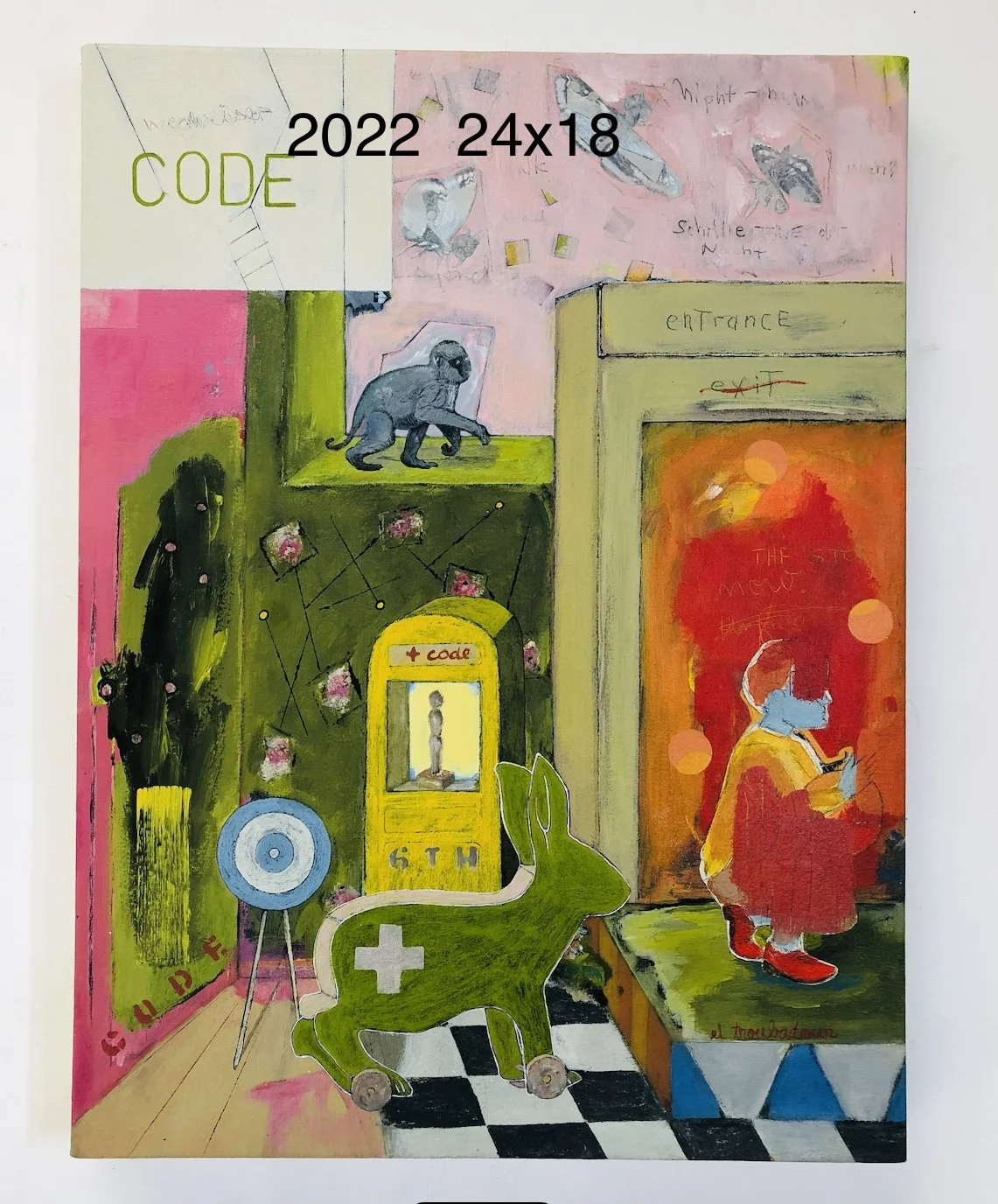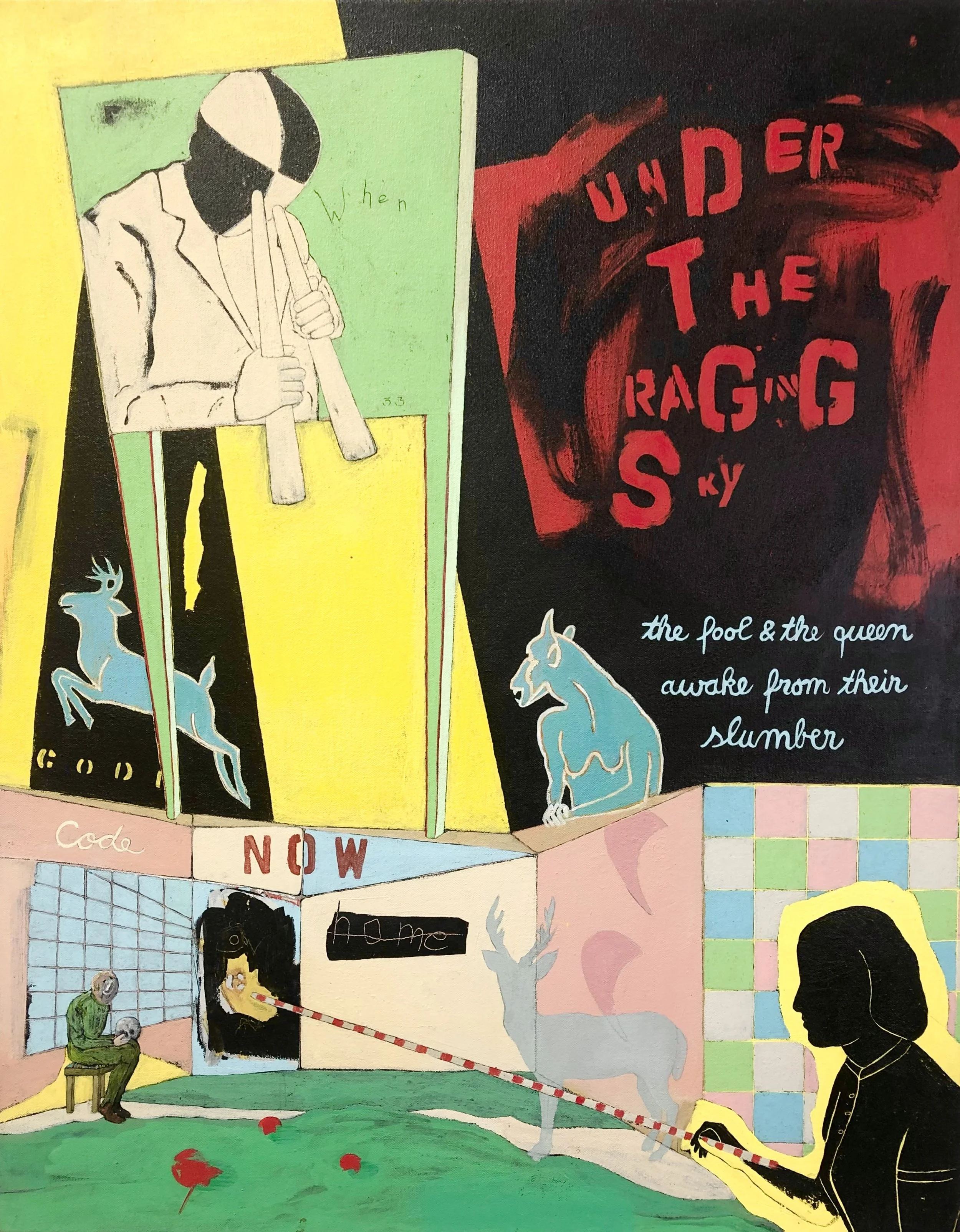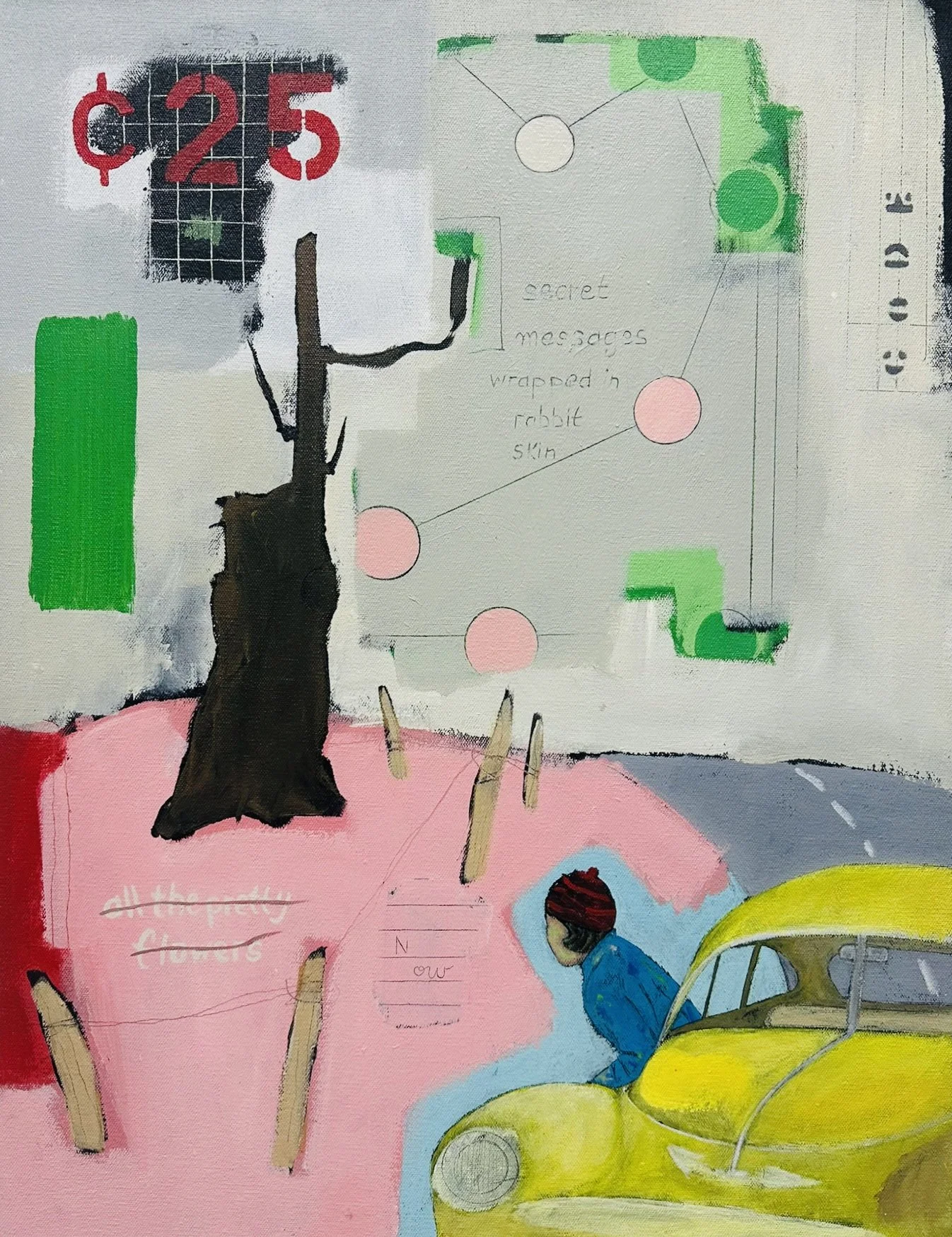Between Heaven & Hell, 2021. Acrylic on canvas. 24 x 24 inches.
Ariane Ahlmann
ARTIST STATEMENT
My work addresses the dark side of human nature, such as the abuse of power and greed. Even though I explore the universal and timeless aspects of human behavior and their interconnections, my paintings are not detached from contemporary urgent matters. The manmade challenges that we face in the 21st century, like climate change, the decline of democracy and racism are recurrent themes of my work.
I take modern and postmodern concepts to combine them into something new. I dissolute the linear and coherent narrative by selecting random visual and textual fragments. In addition to the two-dimensional concept of space, I evoke a certain spatial depth through incorrect or multiple perspectives, distorted scale relations, and superimpositions as a way to reflect the many layers of reality. Much of my pictorial repertoire is symbolically charged with social critique and in contrast to that I integrate symbols of hope.
I have an automatic approach, which is guided by an intuitive logic and subconscious vision. This technique gives me the freedom to channel my thoughts on our human behavior, our struggles and fears.
Interview with Ariane Ahlmann
Can you tell us a bit about your background and how you became interested in becoming an artist?
I grew up in former West Berlin. The city’s counterculture back then had a huge impact on my artistic development. Even though I always felt that I was born to make art, I never attended an art school and my development as an artist was rather unconventional. In my twenties I worked as a photographer for a local newspaper. It wasn’t very creative, but it allowed me to get to know established artists and to witness their creative processes closely. Berlin’s cultural scene was a place for artistic experimentation where everything was possible. It was a wild playground where art, music, and other media overlapped. My first canvases were walls in clubs and the Berlin Wall. Murals in open spaces like these were generously fostered by the city. My painting style back then was gestural and vigorous; clearly influenced by Neo-Expressionism, the dominant artistic movement at that time.
Messages, 2022. Acrylic on canvas. 20 x 26 inches.
Can you tell us about some of your most memorable early influences?
Frequent visits to Berlin’s Neue Nationalgallerie were my first contact with contemporary art. Especially Joseph Beuys’ so called social sculptures had an impact on me and influenced my own sculptures decades later. Even though I could relate to Beuys’ concept of humanism and anthroposophy, it was the visual aspect of his sculptures and his use of materials like found objects, wax, and felt that attracted me. Years later Spanish artist Miguel Barceló had a huge influence on me. Getting to know his work, and seeing his exhibition “La Solitude Organisative” in Barcelona was a turning point for me as an artist. The thick texture and the integration of objects in my early paintings were clearly the result of Barceló’s impression on me. Over the years though, I distanced myself from this technique and focused more on brushstrokes, composition, and subject. During this time the German painter Max Beckmann became my third major artistic influence. His loose brushstrokes, distorted perspectives, and social allegories captured me and still nurture my growth as a painter.
Where are you currently based and what brought you there? Are there any aspects of this specific location or community that have inspired your work?
I live and work in Brooklyn, NY. My move to New York City was family related.
Industrial buildings and abandoned places in decay, like the ones you find in Brooklyn have always fascinated me. It’s the raw beauty and the mysterious emptiness of these sites that I love to integrate in my work.
What is your studio space like? What makes your space unique to you?
In comparison to many artist studios that I’ve seen in New York City, my workspace is rather big. What I think makes it really unique is the fact that it has a window. That may not sound like much, but having a window and enough space to work freely is a luxury in a city like New York, unless you’re able and willing to spend a fortune on rent. I also love the fact that I’m located in an industrial building full of other artists. I can work privately, and at the same time I’m not alone. Conversations and interactions with fellow artists are important to me.
No Exit, 2022. Acrylic on canvas. 24 x 18 inches.
What is a typical day like? If you don't have a typical day, what is an ideal day?
My weekdays start with coffee, emails, social media, and phone calls. After that I complete my morning to-do list and head to my studio to work for about six hours. After six hours my concentration typically starts to drop, which is my cue to wrap up my work for the day.
What gets you in a creative groove or flow? Is there anything that interrupts your creative energy?
The work process itself gets me in the flow. My work doesn’t come easily and it normally takes me about two hours until I start feeling comfortable. Certain social or political events that effect me emotionally can trigger a creative reaction as well. For example, my painting “Burned Soil” was a spontaneous response to the Russian invasion of Ukraine. Emotional or physical stress on the other hand can interrupt my creative energy.
How do you maintain momentum in your practice?
Consistency is key. Painting is a necessity for me, a force that keeps me going. It gives me great pleasure and at times struggle. There are constant ups and downs. I need this kind of challenge. I guess it’s just the right mixture that drives and balances me.
What medium/media are you working in right now? What draws you to this particular material or method?
I’m working with acrylic paint. I like the fact that you can make it look like oil paint without its toxic side effects. Another important factor of acrylics is that it enables me to be more environmentally friendly, since I don’t pour the paint rinse water down the drain. Instead I let it evaporate and then dispose the hardened paint in the trash. Acrylic paint also allows me to incorporate collage into a painting, a technique which I like to use from time to time.
Can you walk us through your overall process in making your current work? Does drawing play a role in your process?
My first step is a black underpainting. I love how the black stays visible here and there once I layer colors over it. The following step is the planning of the pictorial space. Once I have a vague idea I outline the space with chalk, which I later remove. I like to sketch with chalk because it doesn’t leave any traces once removed. I work with images from different sources like magazines and Taschen art books. I cut these preliminary images and arrange them as a first draft on my canvas to get an idea of the visual mood. As I build the pictorial content I adjust the space. As soon as I have achieved a vague idea of the content and space I start outlining the shapes of figures and remove my preliminary images. From there it’s a constant adjustment and shifting of visual elements. The whole process is guided by a very subconscious flow. At some point the painting itself takes over and I’m just channeling and implementing. The most interesting moment can happen towards the end of a painting day when I get stuck or frustrated with the process. That’s the moment when I get courageous and either ruin a whole day’s work or make a visually compelling and interesting adjustment. A single brushstroke can alter the entire painting.
Raging Sky, 2022. Acrylic on canvas. 24 x 30 inches.
What is exciting about your process currently?
I’m currently adding burnt sienna, a typical Renaissance color, to my limited color palette. I love how this earthy color resonates with my usual color choices that vary between saturated and pastel colors. I find this visually new and refreshing.
Can you talk about some of the ongoing interests, imagery, and concepts that have informed your process and body of work over time? How do you anticipate your work progressing in the future?
Before I became a painter I was a collage artist. I later combined the collage technique with painting until I entirely started focusing on the latter. You can tell that the concept of collage is still present in my work. By combining random visual elements and textual fragments that seem detached from each other, I create fictional scenarios often in stage-like settings. The figures in my paintings often resemble cutouts and the perspective of the pictorial space is often distorted like in a typical collage. In regard to the progress of my work, I intend to increase and refine the visual richness and complexity of my paintings without overloading them.
Do you pursue any collaborations, projects, or careers in addition to your studio practice? If so, can you tell us more about those projects, and are there connections between your studio practice and these endeavors?
No, at the moment my studio work is all I do. Working on my own is where I feel most comfortable, though it is important to leave your comfort zone from time to time. That being said, I am open to collaborations, especially in other fields.
Have you had any epiphanies recently that have changed the course of your work or caused you to shift directions?
Yes, about two years ago the pictorial space of my paintings shifted from two-dimensions to three-dimensions, leaving the planar surface behind and replacing it with spatial depth. At the same time I reduced my color pallet in search for new coloristic climates and strategies. I like to create more complexity not only in space, but also in mood and tone. It’s a new stage in my artistic development and it feels exciting.
Wonderland, 2022. Acrylic on canvas. 20 x 24 inches.
Can you share some of your recent influences? Are there specific works—from visual art, literature, film, or music — that are important to you?
The influence of German artist Neo Rauch on my work triggered the shift in my paintings that I just mentioned. His unusual use of pictorial space and his radical color palette have a powerful impact on my work. Much of what I taught myself is through his work, especially his use of color. Rauch’s conception of imaginative space is linked to various narratives, something you find in my work as well. Like Rauch, I dismiss linear storytelling, giving way to a more fragmented narrative. Of course I’m not only influenced by visual artists. Books like “Berlin Alexander Platz” written in 1929 by Alfred Döblin are an inspiration to me when it comes to narrative fragmentation and juxtaposition. Then there is filmmaker Wes Anderson whose unusual, saturated color symbolism fascinates me. I like how he tears the traditional color theory apart to create a unique mood and tone, which I like to strive for in my own work.
Who are some contemporary artists you’re excited about? What are the best exhibitions you’ve seen in recent memory and why do they stand out?
The exhibition “The Eye Is Not Satisfied With Seeing” by American artist Jennifer Packer at the Whitney Museum blew my mind. I was instantly drawn to her loose lines and brush strokes, and to her limited color palette. Packer presents our complex world not by explaining but by giving the viewer room for interpretation, something I aim for in my own work.
Another amazing exhibition was Anselm Kiefer's "Exodus" at the Gagosian Gallery. Kiefer has been my favorite German artist for years. I love his idea that all life is in a cycle of ruin and rebirth. Even if humanity were to be wiped out, there would still be some bacteria that would trigger new life. Kiefer’s monumental paintings often resemble burned soil and destruction, but here and there you can see signs of life arising from the ashes.
El Camino, 2022. Acrylic on canvas. 18 x 24 inches.
Do you have any tips or advice that someone has shared with you that you have found particularly helpful?
Be consistent in what you love doing the most.
What are you working on in the studio right now? What’s coming up next for you?
I’m working on an allegorical triptych in dominant earth tones.
If everything works out, I’ll have three group shows coming up this spring and early summer. Two in galleries in New York City and Ohio, and one at an art museum in upstate New York.
Anything else you would like to share?
Yes, maybe a last thought. My own trajectory as a painter shows that it’s never too late to reinvent yourself. I remember the time when I decided to become a full time artist. I was driven and at the same time scared of the unknown. One night back then I had a dream that I remember vividly. In that dream I was locked in a room with walls covered in mirrors. Instead of seeing myself in these mirrors I saw demons attacking me, and I had to fight them fiercely. Not long after that dream I was ready to take on the challenge of dedicating myself to painting. The creative process consists of constant ups and downs but at the same time you learn about yourself and the world around you.
Thank you so much for sharing your work with us!
To find out more about Ariane Ahlmann check out her Instagram and website.






